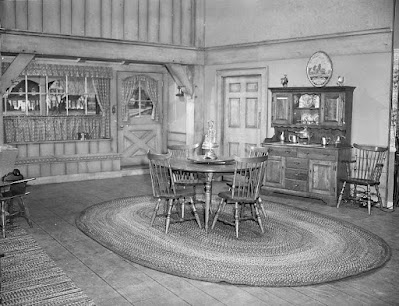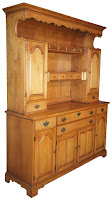
"Early American furniture is something completely different. The style is not an exact copy...it is made to give the illusion of early American furniture, but to be more functional in the contemporary 20th-century home."
Even before America's one-hundredth birthday, there was tremendous demand for furnishings and items that dated to the later half of the 1700's. Everyone wanted a piece to display for the anniversary. The problem was supply versus demand. There were not that many original pieces available as most were used up or lost in the intervening years. Nevertheless, demand still remained high, but there was a solution...recreate the furniture using the original designs. These copies became known as "centennial" furniture. Most of these copies were extremely well-made, using exquisite hardwoods, hardware, and decorations...in some cases it's indistinguishable from furniture produced in the 18th-century. This genre of furniture is known overall as Colonial Revival and spans from the late 19th-century all the way up to the present. Reproductions of 18th and even 17th-century furnishings has never ceased. You can buy an exact copy of an 18th-century Windsor chair, or a Philadelphia or Boston made High-Boy dresser, or a blanket chest today. It will be made just like it was back then, by hand...only it was made yesterday and is not antique or original.
Early American furniture is something completely different. The style is not an exact copy...it is made to give the illusion of early American furniture, but to be more functional in the contemporary 20th-century home. For example, there are no magazine holders or telephone tables in the retinue of Colonial furniture, but for "Early American" style, these pieces of furniture can be made with stylistic aspects from the 1700s while still being functional for a modern home.
Some manufacturers stayed close to to the look of original colonial furniture like Drexel, others like Ethan Allen did not, but all fall into the "Early American" style category. In the 1950's this style boomed in popularity. The WWII generation was settling down, having families, and the economy was very good. More people than ever were living comfortably in the largest expansion of middle-class America ever seen. "Early American" furniture, or some derivative, was the style seen in most of these homes.
"Early American" exhibited a multitude of turned wood legs and scalloping, almost to the extreme, with most examples being made of maple. Chairs and couches used garish upholstery, with bright colors or patterns that interspersed American themed objects like lamps, flags, sailing ships, horse drawn carriages, or patriotic symbolism. In recent years this style has been dubbed "Coloniawful", referencing a mass-produced, poorly balanced copy that diverges from true American furniture from the 18th or early 19th-century with a separation from "Colonial Revival" as well. "Early American" was made to inspire middle-class Americans into furnishing their homes with something that hearkened back to their roots, yet still enjoyed functionality. It is a true American style, well-made but in many cases downright ugly. Perhaps that's the secret of it's charm...and the resurgence of popularity in the mid-century vintage furniture market.
"Colonial Revival" ranch homes incorporated architectural features that would remind one of homes built on America's east coast in the 1700's, like dormer windows and wrought iron fixtures. Colonial was not the only choice, you could also choose a ranch home in Spanish or Mission revival that would have exterior features emulating adobe architecture of Spanish California and the Southwest. There we also "South Seas" ranch homes that took advantage of the rage for something out of Tales of the South Pacific and the "tiki" fad. Another style known as Storybook or "Cinderella", would include exteriors that were steeped in fantasy, reminding one of a gingerbread house straight out of a fairytale. By and large, the furnishing gracing these middle class homes of the 1950's and 60's were "Early American" styles. A European "storybook fantasy" on the outside, a rural American theme on the inside.
Typical "Cinderella" or "Storybook" ranch home from the 1950's-1960's
The final phase in "Early American" furnishings came in the mid-1970's. The United States was approaching its Bicentennial in 1976 and any piece of furniture that looked even remotely like it came from the 18th-century was in vogue. "Bicentennial Chic" was the high water mark for "Early American" pieces, and the form had developed to almost outlandish proportions. Extremely large and ornate turnings, exaggerated chair backs, garish upholstery, very chunky construction and dark stains...all hallmarks of this last phase of "Early American" or "Coloniawful" at its peak. Some furnishings were made exclusively for the 200th anniversary with Bicentennial limited editions produced, many having patriotic decals or painted embellishments applied to take advantage or commemorate the event...



























